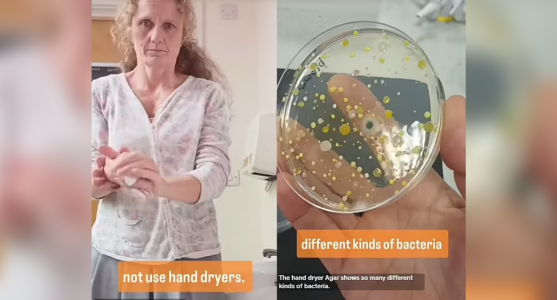The Shocking Truth About Public Hand-Dryers – Here's Why You Should Avoid Them Forever!
By
- Replies 9
Regarding public restrooms, we've all been taught the importance of washing our hands thoroughly to prevent the spread of germs. But what happens after we've scrubbed and rinsed? Many of us head straight for the hand dryer, assuming it's the most hygienic and environmentally friendly way to finish the job. However, recent findings suggest you rethink that choice and reach for paper towels instead.
A scientist known as Devon Science on TikTok has conducted an experiment that reveals a rather stomach-churning truth about the hand dryers we often use without a second thought. The video, which has garnered a staggering 4.7 million views, shows the scientist placing a petri dish under a hand dryer in a public restroom to collect the bacteria expelled by the machine. The results were nothing short of alarming.
After leaving the collected samples to incubate overnight, the petri dish was exposed to the hand dryer and teemed with various bacteria and fungus, visible as white, yellow, and black smudges. In stark contrast, a control dish waved through the air—simulating the action of shaking hands dry—remained completely clear. This visual evidence is enough to make anyone's skin crawl and question the cleanliness of these devices.
But the experiment continued. Devon Science also tested a piece of toilet paper she had used to dry her hands, pressing it onto a petri dish. While bacteria did grow from this sample, it was significantly less than what was found in the hand-dryer dish. The most telling part of the experiment, however, was when she swabbed the inside vent of the hand dryer. The cotton bud emerged black with grime, and the corresponding petri dish was filled with various bacteria similar to those found in the initial hand-dryer sample.
This revelation is particularly concerning when considering the types of bacteria that can be found in public restrooms. Studies have shown that E. coli, hepatitis, and other fecal bacteria are commonly present in these environments. Hand dryers, which are designed to blow air rapidly to dry hands, maybe sucking in this contaminated air and spraying it directly onto our freshly washed hands.
A 2018 study by researchers at the University of Connecticut and Quinnipiac University supports this notion. They found that hot-air hand dryers in public restrooms could pull in bacteria from the air and deposit them onto clean hands. When they equipped the dryers with HEPA filters, which are designed to capture bacteria and other pollutants, the number of bacteria collected in the Petri dishes decreased by 75 per cent. This suggests that a significant portion of the bacteria being dispersed by hand dryers originates from the restroom air.
So, what should you do the next time you're in a public restroom? Based on these findings, it seems the safer option is to skip the hand dryer altogether. Opt for paper towels when available, or if you're in a pinch, shake your hands dry and use your elbow to open the door as you leave. It's also worth advocating for better maintenance and cleaning of hand dryer units and the installation of HEPA filters to minimise the spread of bacteria.
 At the Seniors Discount Club, we understand that staying healthy is paramount, especially as we age and our immune systems may not be as robust as they once were. We encourage our members to share this information with friends and family to help protect our community's health. Have you had a similar experience with public hand dryers, or do you have other tips for staying germ-free in public spaces? Join the conversation in the comments below, and let's help each other stay informed and healthy!
At the Seniors Discount Club, we understand that staying healthy is paramount, especially as we age and our immune systems may not be as robust as they once were. We encourage our members to share this information with friends and family to help protect our community's health. Have you had a similar experience with public hand dryers, or do you have other tips for staying germ-free in public spaces? Join the conversation in the comments below, and let's help each other stay informed and healthy!
A scientist known as Devon Science on TikTok has conducted an experiment that reveals a rather stomach-churning truth about the hand dryers we often use without a second thought. The video, which has garnered a staggering 4.7 million views, shows the scientist placing a petri dish under a hand dryer in a public restroom to collect the bacteria expelled by the machine. The results were nothing short of alarming.
After leaving the collected samples to incubate overnight, the petri dish was exposed to the hand dryer and teemed with various bacteria and fungus, visible as white, yellow, and black smudges. In stark contrast, a control dish waved through the air—simulating the action of shaking hands dry—remained completely clear. This visual evidence is enough to make anyone's skin crawl and question the cleanliness of these devices.
But the experiment continued. Devon Science also tested a piece of toilet paper she had used to dry her hands, pressing it onto a petri dish. While bacteria did grow from this sample, it was significantly less than what was found in the hand-dryer dish. The most telling part of the experiment, however, was when she swabbed the inside vent of the hand dryer. The cotton bud emerged black with grime, and the corresponding petri dish was filled with various bacteria similar to those found in the initial hand-dryer sample.
This revelation is particularly concerning when considering the types of bacteria that can be found in public restrooms. Studies have shown that E. coli, hepatitis, and other fecal bacteria are commonly present in these environments. Hand dryers, which are designed to blow air rapidly to dry hands, maybe sucking in this contaminated air and spraying it directly onto our freshly washed hands.
A 2018 study by researchers at the University of Connecticut and Quinnipiac University supports this notion. They found that hot-air hand dryers in public restrooms could pull in bacteria from the air and deposit them onto clean hands. When they equipped the dryers with HEPA filters, which are designed to capture bacteria and other pollutants, the number of bacteria collected in the Petri dishes decreased by 75 per cent. This suggests that a significant portion of the bacteria being dispersed by hand dryers originates from the restroom air.
So, what should you do the next time you're in a public restroom? Based on these findings, it seems the safer option is to skip the hand dryer altogether. Opt for paper towels when available, or if you're in a pinch, shake your hands dry and use your elbow to open the door as you leave. It's also worth advocating for better maintenance and cleaning of hand dryer units and the installation of HEPA filters to minimise the spread of bacteria.
Key Takeaways
- A scientist on social media exposed high levels of bacteria and fungus ejected from hand dryers in public restrooms.
- The experiment demonstrated that hand-dryer bacteria are substantially more abundant than bacteria from the air in a laboratory or from shaking hands dry.
- One petri dish exposed to the inside vent of a hand dryer contained a dense variety of bacteria, indicating that the microbes were living inside the machine.
- Previous research suggests that hand dryers can spread bacteria such as E. coli and other faecal bacteria onto cleaned hands, and fitting hand dryers with HEPA filters could reduce this bacteria transmission by 75 per cent.








